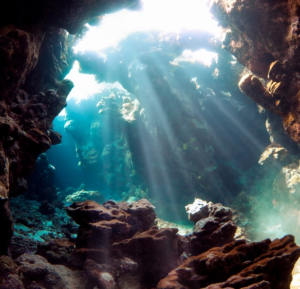Science & Data Document Library
Science and Data Resources
Comprehensive and Critical Period Monitoring Program to Evaluate the Effects of Variable Flow on Biological Resources in the Comal Springs/River Aquatic Ecosystem Final 2003 Annual Report

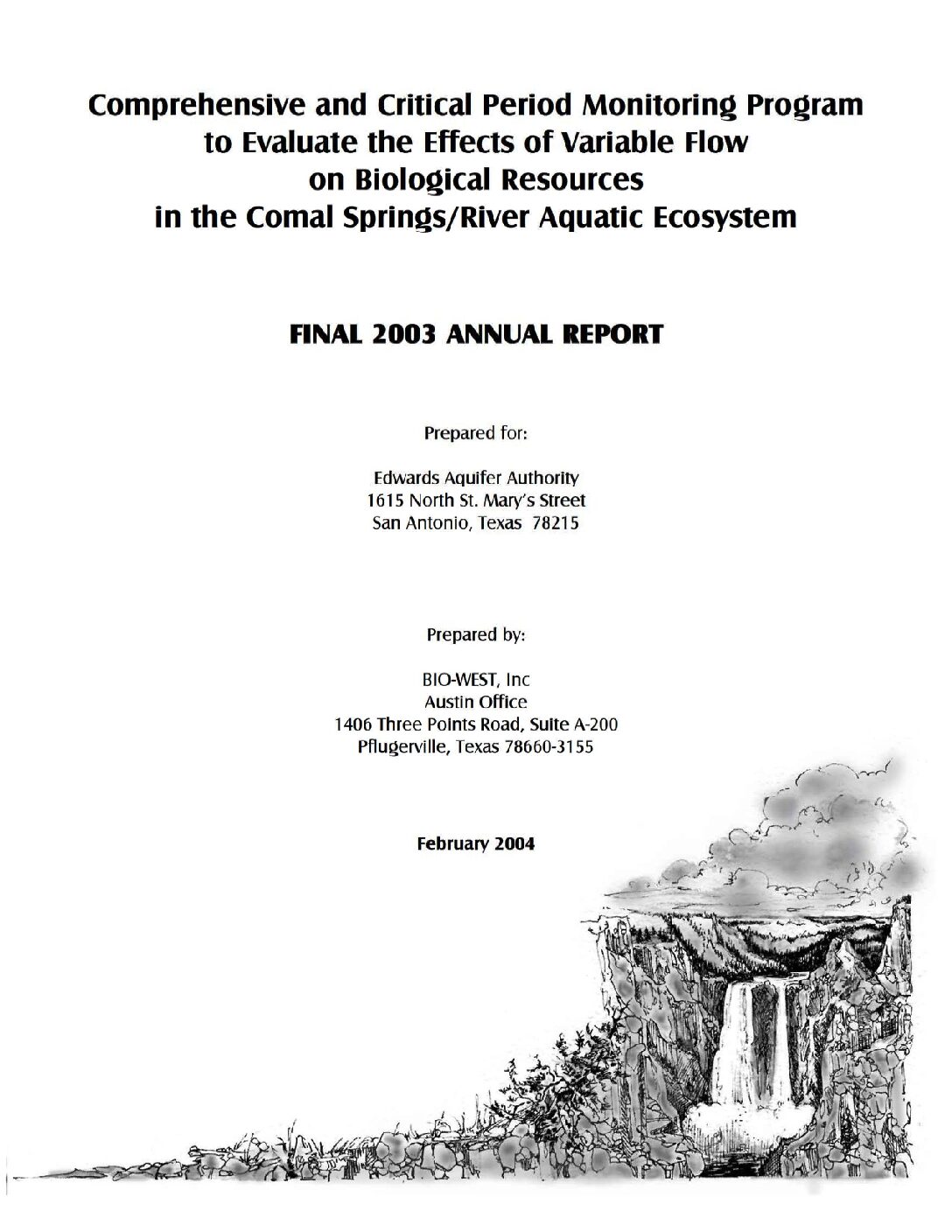
Description: Annual report for 2003 on biota study of Comal Springs/River
Location: Comal Springs/River
Summary:The purpose of this report is to document the results of all aquatic ecosystem monitoring conducted in 2003 at Comal Springs located in New Braunfels, Texas. The monitoring and report preparation was performed by BIO-WEST, Inc. Pflugerville, Texas.
[Excerpted from the Executive Summary
This annual summary report presents a synopsis of methodology used and an account of sampling activities, including sample conditions, locations and raw data obtained during three quarterly sampling events (Comprehensive Monitoring Effort), conducted on the Comal Springs/River ecosystem in 2003. There were no low-flow critical periods or high-flow events triggered in 2003. In 2003, flows remained high through the summer and did not follow the typical pattern of decline.
In 2003, flows remained high through the summer and did not follow the typical pattern of decline. In 2003, flows remained high through the summer and did not follow the typical pattern of decline. Baseline data have continued to show that the Comal River is an ecosystem with high water quality according to the chemical and physical variables that were measured.
After the scouring effects of floods in both 2001 and 2002, many vegetation types responded with rapid re-growth and expanded to a total coverage that was far greater than in previous samples. For the most part, these increases in vegetation coverage were maintained throughout 2003. However, there was some decline in coverage that occurred in the fall of 2003 in many reaches despite the high flows and presumably favorable conditions. This emphasizes the fact that conditions are dynamic even when flows remain relatively constant and habitat should not be predicted on flows alone.
One of the more important observations with vegetation composition in 2003 was the dramatic shift in habitat within the Old Channel Reach. Prior to 2003, filamentous algae dominated this reach and provided the highest quality habitat (supported the greatest density) for fountain darters. Beginning in the fall of 2002 Hygrophila and later Ludwigia appeared in the reach and have grown significantly in 2003 to nearly complete coverage of areas that had previously supported filamentous algae.
In previous years, the greatest number of fountain darter observations occurred in the spring and the fewest in the fall, but that trend was reversed in 2003. Two areas of additional concern to fountain darters, the density of giant ramshorn snails (Marisa cornuarietis) and evidence of gill parasites on fountain darters, were monitored in 2003. By all indications the densities of giant ramshorn snails observed in the Comal ecosystem during the study period to date (including the 2000 low-flow events) pose no serious threat to the aquatic vegetative community (i.e., fountain darter habitat). However, because of the impact that this exotic species can have under heavier densities, close monitoring of this species should continue. Gill parasites were found on fountain darters in varying densities among different sample areas and appear to be concentrated in areas with slow-moving water and high snail densities.
It is difficult to evaluate the influence of springflow on the abundance of invertebrates found in the net because discharge remained so similar among the three sample events in 2003, however, some interesting patterns emerged.
Comal Springs salamanders were observed in each [Spring Island ] area during each sampling event. In 2003, stable flows reduced the sediment accumulation and more salamanders were observed in the Spring Run 3 sample area. As documented via SCUBA surveys, the Comal Springs salamander population was maintained in the deeper portion of Landa Lake throughout the study period.
More data from lowflow periods (particularly from an extended low-flow period) are essential to fully evaluate the biological risks associated with future critical periods (high or low flow). This study remains the most comprehensive biological evaluation that has ever been conducted on the Comal River ecosystem.
Comprehensive and Critical Period Monitoring Program to Evaluate the Effects of Variable Flow on Biological Resources in the Comal Springs/River Aquatic Ecosystem Final 2010 Annual Report

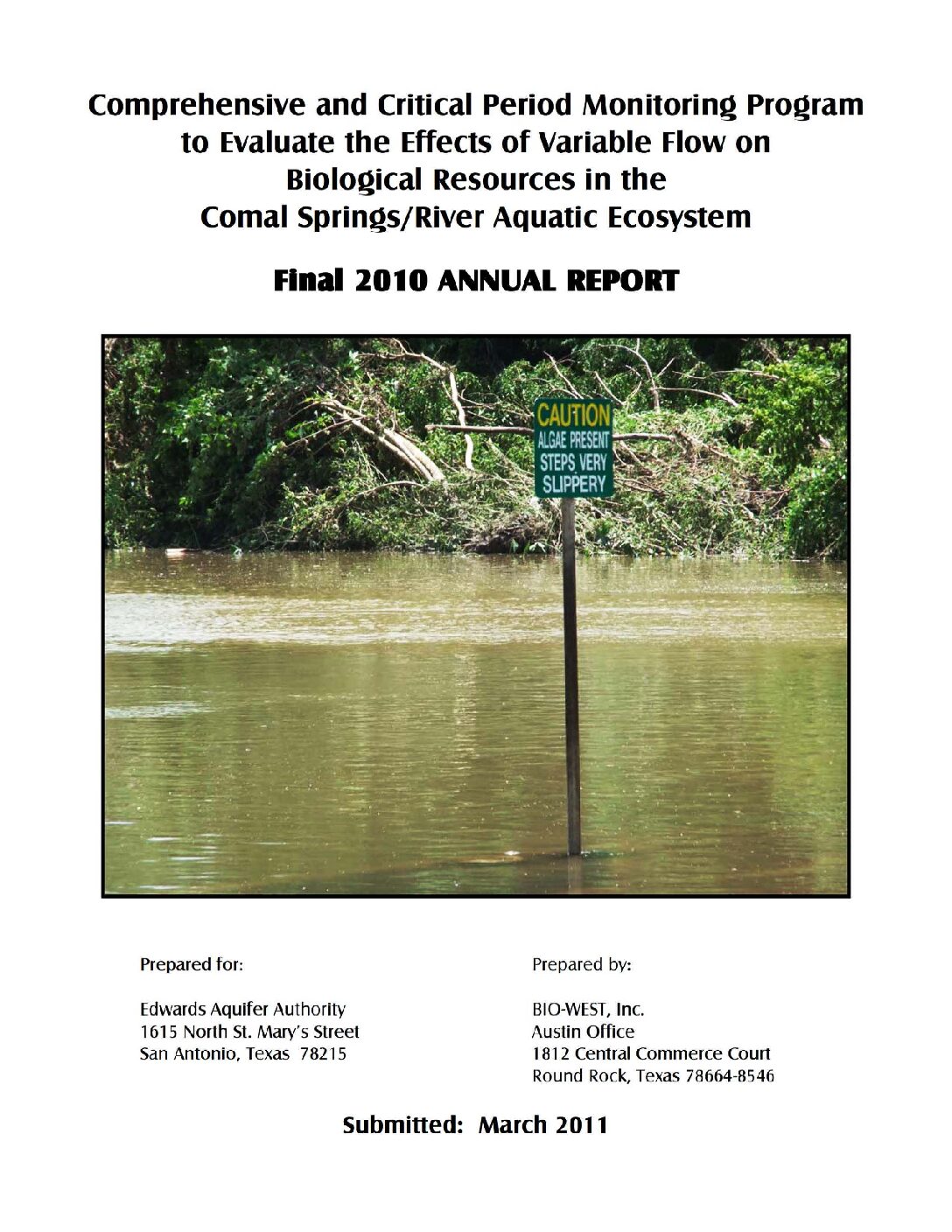
Description: Annual report for 2010 on biota study of Comal Springs/River
Location: Comal Springs/River
Summary:The purpose of this report is to document the results of all aquatic ecosystem monitoring conducted in 2010 at Comal Springs located in New Braunfels, Texas. The monitoring and report preparation was performed by BIO-WEST, Inc. Pflugerville, Texas.
[Excerpted from the Executive Summary]
This annual summary report presents a synopsis of methodology used and an account of sampling activities conducted during three sampling events (two Comprehensive Monitoring efforts and one Critical Period high-flow effort) on the Comal Springs/River ecosystem in 2010. In 2010, increased rainfall and subsequent aquifer recharge allowed central Texas to come out of the drought that it had experienced for the past couple of years. Flows were above the historic average in the Comal River to begin 2010, which was a trend that continued throughout the entire year. In early June, a major flood event occurred on the Comal River. The flows on June 9, 2010 peaked at 7,280 cubic feet per second (cfs), the highest daily average since 2002 (13,400 cfs). This Critical Period event was caused by an 18-hour rainfall total of 7 12 inches, with much of it centered over the City of New Braunfels. Extensive damage to areas adjacent to the Comal River occurred.
Aquatic vegetation at the four study reaches were affected by increased spring flows and the flood event in 2010. The flooding in June changed the Upper Spring Run Reach the most because a lot of the flow came down Blieder's Creek, hich enters the Comal River just upstream of this reach. Over 80% of the aquatic vegetation in this reach was removed by the high-flow event, and only strongly-rooted Sagittaria remained. By fall, Hygrophila and bryophytes had regained a toe-hold in the reach, but vegetation remained scarce. Other native vegetation (Ludwigia, Sagittaria, Cabomba) were reduced after the flood, but by fall they had reestablished in most areas where they were previously found.
Unfortunately, flooding in June decimated much of the bryophytes and filamentous algae which are most vulnerable to scouring in high flows. This resulted in the lowest normalized population estimate of fountain darters since the inception of the study. Impacts were most notable at the Old Channel and Upper Spring Run sites because much of the vegetation was removed in these reaches (filamentous algae and bryophytes were absent from both sites in June). Fountain darter populations began to recover by fall, and if previous high-flow events are any indication, they should continue to increase as aquatic vegetation grows back.
Gill parasites in the Comal River were monitored throughout 2010. A specific study at three sites was conducted to compare overall gill parasite concentrations from 2010 to those observed during 2006. A significant decline in cercarial densities was observed from 2006 to 2010.
Comal Springs salamander (Eurycea sp.) populations decreased at all sites following the June flood except at the Spring Island East Outfall. Sampling of invertebrate populations is confined to areas near spring upwellings because these animals often are not observed until they are released or come out of the springs. As a result, these populations seemed less affected by the flooding than other aquatic organisms studied in the Comal River.
Unfortunately, the flooding did affect the Comal Springs riffle beetle (Heterelmis comalensis) sampling effort because many of the lures (cotton rags) used to catch these invertebrates were washed away or buried by shifting substrates. In 2010, a new locality for the Comal Springs riffle beetle and Peck's Cave amphipod (Stygobromus pecki) was chosen just downstream of the confluence of Spring Runs 1 and 2. As in previous years, populations were patchily distributed and abundance varied considerably in 2010.
The flood in June resulted in a myriad of effects on the biota in the system. Data from the past 10 years indicate that the Comal River/Springs ecosystem contains a highly resilient ecological community that is able to withstand these types of events. However, anthropogenic and natural stressors will likely continue to exacerbate the magnitude and frequency of high and low-flow events into the future. Therefore, continued monitoring and applied research will be vital to provide guidance on management strategies necessary for preserving this unique ecosystem.
Comprehensive and Critical Period Monitoring Program to Evaluate the Effects of Variable Flow on Biological Resources in the Comal Springs/River Aquatic Ecosystem Final 2009 Annual Report

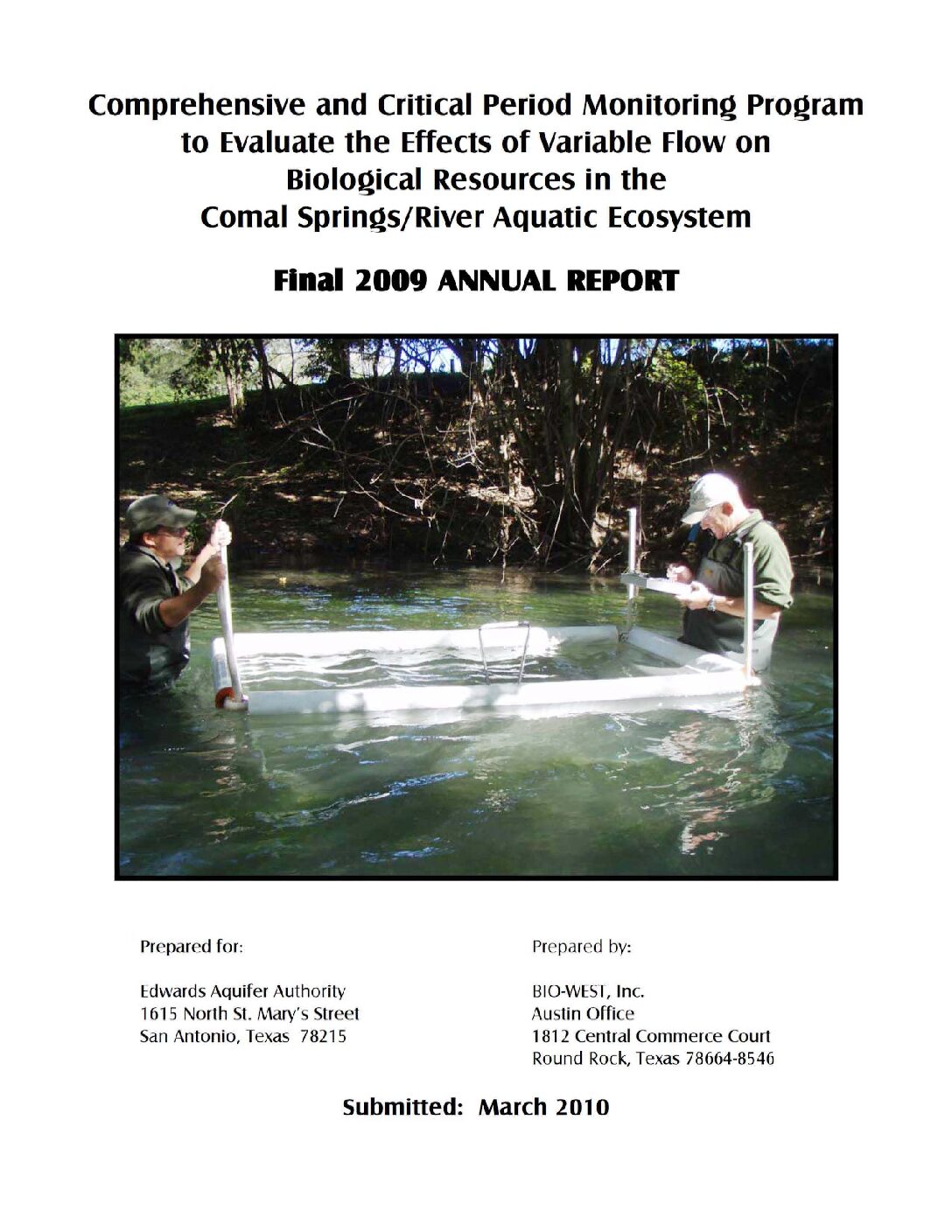
Description: Annual report for 2009 on biota study of Comal Springs/River
Location: Comal Springs/River
Summary:The purpose of this report is to document the results of all aquatic ecosystem monitoring conducted in 2009 at San Marcos Springs located in San Marcos, Texas. The monitoring and report preparation was performed by BIO-WEST, Inc. Pflugerville, Texas.
[Excerpted from the Executive Summary]
This annual summary report presents a synopsis of methodology used and an account of sampling activities conducted during three sampling events (two Comprehensive Monitoring efforts and one Critical Period low-flow effort) on the Comal Springs/River ecosystem in 2009. The year 2009 was the culmination of a prolonged drought in central Texas that began in 2007. Discharge in the Comal River was at its lowest since 2000.
The variable flows of 2009 had a myriad of effects on the aquatic vegetation in all reaches. Fountain darter abundance in the Comal River was again variable in 2009, but within the range of previous years observed throughout this study. In areas near spring upwellings with native vegetation (e.g., bryophytes) there appears to be year-round reproduction. However, dip net data confirm an early spring reproductive peak for these fish in other areas of lower quality habitat.
Although the total number of Comal Springs riffle beetles (Heterelmis comalensis) captured decreased slightly from 2008 to 2009, numbers were similar to those observed in 2007. The total number of salamanders observed during the spring and Critical Period sampling efforts were the highest since the inception of the study.
Flows from Comal Springs in 2009 were the lowest observed since 2000, but impacts on the biota in the ecosystem appeared to be minimal. Continued monitoring over an extended period of lower than average flows is necessary to fully understand the impact of discharge on the varied biota in the system.
Comprehensive and Critical Period Monitoring Program to Evaluate the Effects of Variable Flow on Biological Resources in the Comal Springs/River Aquatic Ecosystem Final 2008 Annual Report

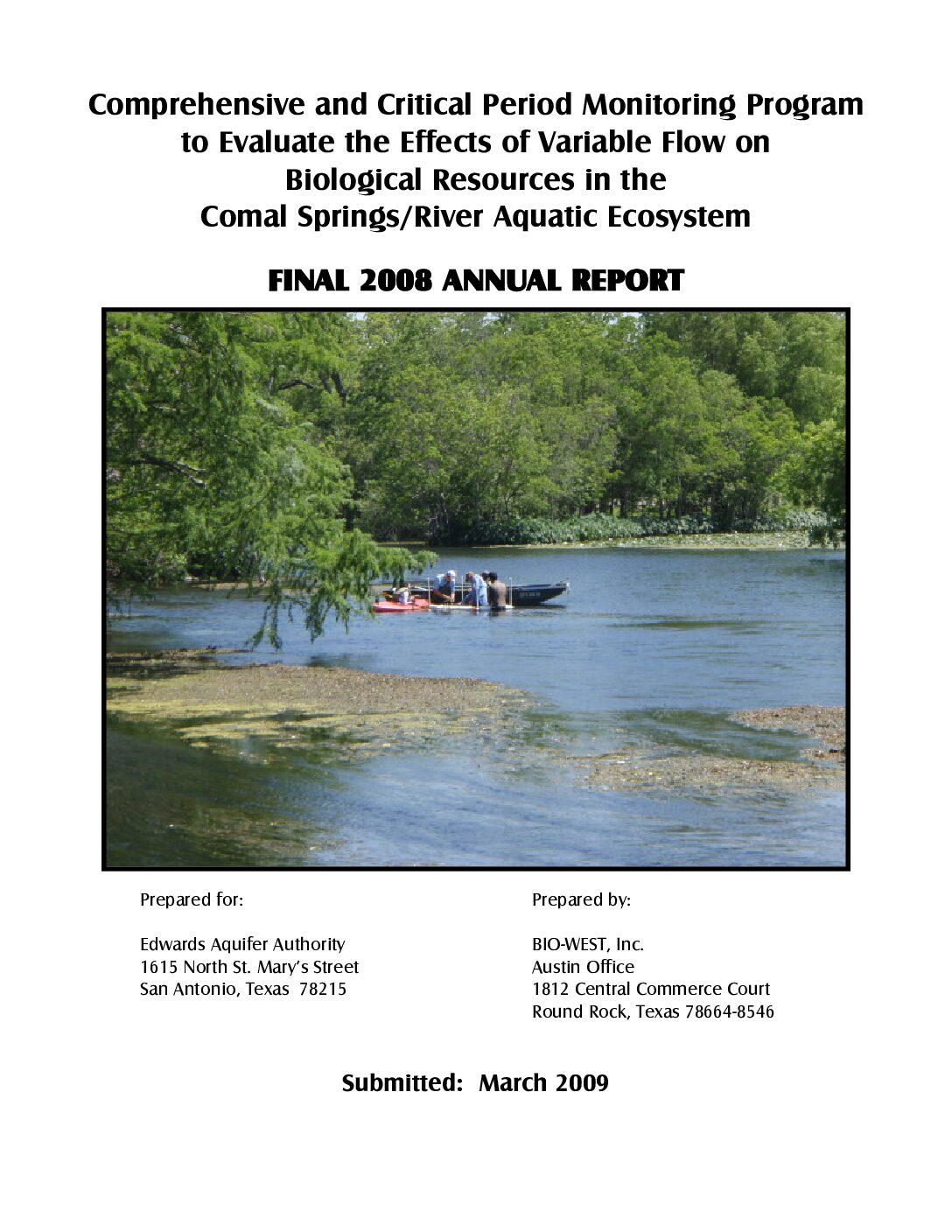
Description: Annual report for 2008 on biota study of Comal Springs/River
Location: Comal Springs/River
Summary:The purpose of this report is to document the results of all aquatic ecosystem monitoring conducted in 2008 at Comal Springs located in New Braunfels, Texas. The monitoring and report preparation was performed by BIO-WEST, Inc. Pflugerville, Texas.
[Excerpted from the Executive Summary]
Discharge in the Comal River was lower in 2008 compared to 2007, but no Critical Period events were triggered. Even with the extreme drought in central Teby fall they became fragmented possibly due to an early fall precipitation event. Vallisneria was the dominant vegetation in Landa Lake in 2008, where it was mostly found in deeper areas of the lake. Non-native Hygrophila dominated the central section of the reach near several islands. Native Ludwigia fragmented more in 2008 and only a handful of small plants remain in Landa Lake.
Filamentous algae covered enough area in the Old Channel Reach in 2008 to justify sampling for fountain darters within it. This is important to note as conditions have not allowed this for several years. Filamentous algae have consistently had the highest density of fountain darters of any vegetation type. Normalized population estimates [of fountain darters] for spring 2008 were the highest recorded since 2003. As in previous years, length-frequency distribution data reflected a spring reproductive peak for fountain darters.
Spring Run 1 and Spring Run 3 yielded almost twice the number of salamanders in 2008 compared to 2007. On the contrary, Spring Island salamander counts were considerably less in 2008. No salamander observations at the Spring Island Spring Run for the third straight sampling session is likely because of the removal of fist-size rocks (preferred habitat) at this site.
Similar to 2007, species of the genus Stygobromus and Lirceolus continued to be most abundant at all sites. Peck's cave amphipod (Stygobromus pecki) was the dominant amphipod at all sites. There were substantially more Comal Springs riffle beetles (Heterelmis comalensis) collected in 2008 than in 2007.
Near average flows in the Comal River in 2008 continued to maintain fountain darter populations in this unique springs system. Non-native and native vegetation continued to compete at several reaches, but with the exception of Ludwigia at Landa Lake, surface areas were similar to 2007. The presence of bryophytes in some of the reaches will continue to harbor large populations of fountain darters. If the central Texas drought continues into 2009, resulting flow decreases may trigger low-flow Critical Period sampling events. These events, although undesirable for the public and environment should provide much needed information on biotic responses to more extreme conditions.
Comprehensive and Critical Period Monitoring Program to Evaluate the Effects of Variable Flow on Biological Resources in the San Marcos Springs/River Aquatic Ecosystem Final 2006 Annual Report

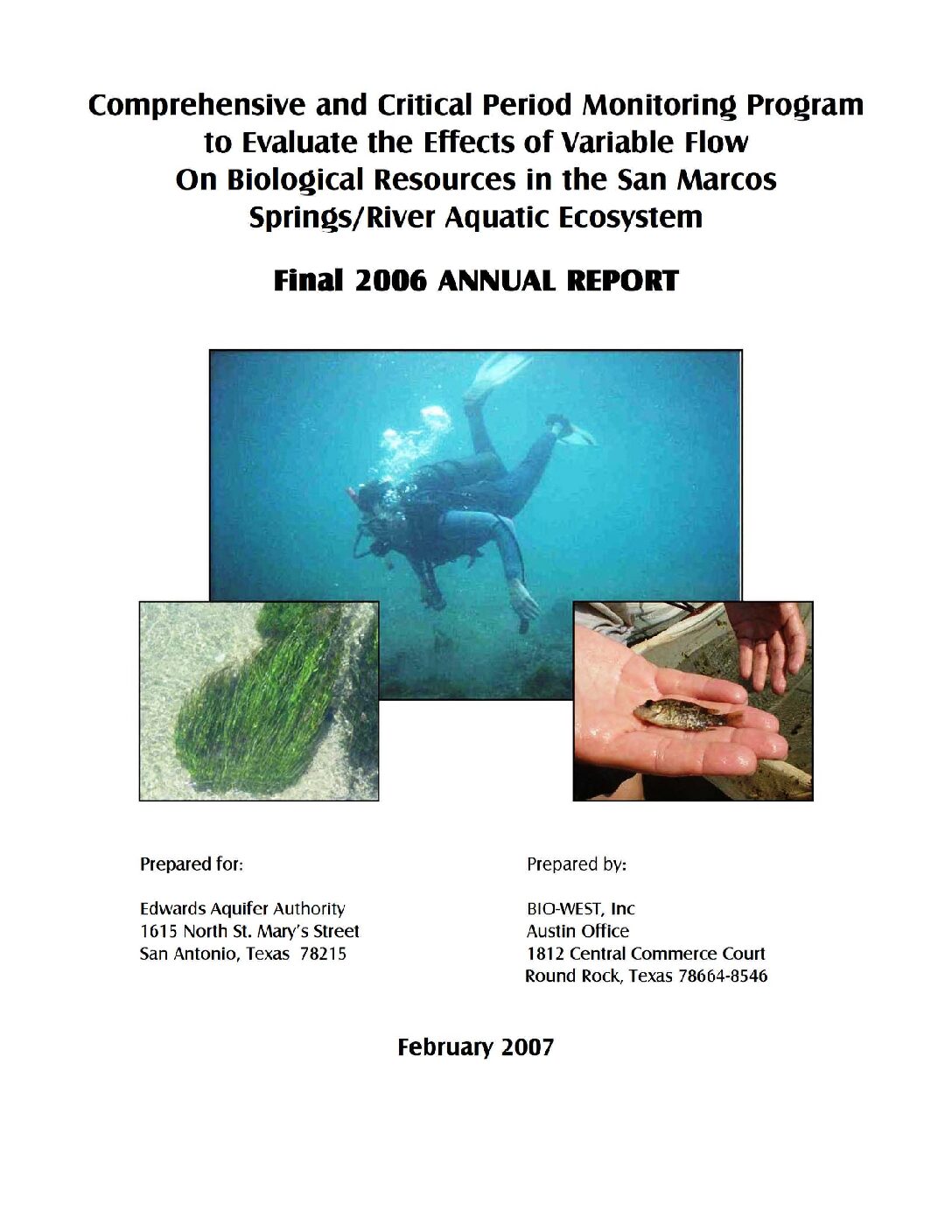
Description: Annual report for 2006 on biota study of San Marcos Springs/River
Location: San Marcos Springs/River
Summary:The purpose of this report is to document the results of all aquatic ecosystem monitoring conducted in 2006 at San Marcos Springs located in San Marcos, Texas. The monitoring and report preparation was performed by BIO-WEST, Inc. Pflugerville, Texas.
[Excerpted from the Executive Summary]
This annual summary report presents a synopsis of methodology used and an account of sampling activities including sampling conditions, locations, and data obtained during two quarterly sampling events (Comprehensive Monitoring Effort) and two Critical Period events conducted on the San Marcos Springs/River ecosystem in 2006. Limited recharge was experienced in 2006, and as a result Critical Period sampling events were triggered when total discharge in the San Marcos River decreased to near 100 cubic feet per second (cfs) in July, and below 95 cfs in September.
The extended period of limited recharge leading up to and extending throughout 2006 caused discharge in the San Marcos River to decline to levels not experienced since 1996. When reviewing the annual discharge in the San Marcos River since the installation of the USGS gage in fall 1956, the 2006 average annual discharge of 112 cfs was the eighth lowest on record.
Water Quality grab samples were collected at multiple sites in Spring Lake and the San Marcos River to evaluate select parameters during the two Critical Period sampling events. Total Suspended Solids (TSS) were low at all sites in Spring Lake, and showed an increasing trend in the San Marcos River between Critical Period events. Nitrate values at the Spring Lake and San Marcos River sites were higher than the average from 2000-2002 for Critical Period 1 with the source of these nitrates most likely water coming out of the springs.
A general trend of decreasing vegetation area was observed at the Spring Lake Dam site in 2006. At the mouth of Sessom's Creek a large island developed as a result of large sediment loads carried by this flashy stream. This new bank was mapped and resulted in a loss of available area for vegetation growth in the Spring Lake Dam Reach. By the first Critical Period event, much of the vegetation had decreased in the vicinity of this island. Another considerable loss of vegetation occurred in this reach in September, when approximately 234 m2 of Texas wild-rice was manually pulled out along the eastern shore of the Spring Lake Dam Reach. It is clear that both the Texas wild-rice removal and rock art were caused directly by humans. By November, the Texas wild-rice in this area had begun to recover, but was still severely fragmented as a result of the mechanical destruction. Texas wild-rice changed little from 2005 to 2006 in the City Park Reach while increasing in the I-35 Reach.
Of all the biological communities monitored in the San Marcos River in 2006, Texas wild-rice in the upper most reaches of the San Marcos River (Spring Lake Dam Reach through Sewell Park) seemed to be affected most by the lower discharge conditions in 2006.
Dip net data and visual observations (SCUBA) from Spring Lake confirmed high numbers of fountain darters throughout 2006 and again demonstrated that small darters are present throughout the year indicating year round reproduction.
Exotic species continue to inhabit the San Marcos River, but did not appear to have any noticeable impacts during the lower discharge conditions of 2006. The sheer number and varying sizes of suckermouth catfish (Hypostomus sp.) that were removed by the U.S. Fish and Wildlife Service (USFWS) biologists during the reconstruction of Rio Vista Dam is cause for concern and close future observation of this exotic species. The rock bass (Ambloplites rupestris) and sailfin molly (Poecilia latipinna) were the most abundant exotic species collected in routine sampling. The giant ramshorn snail (Marisa cornuarietis) can have severe detrimental impacts on vegetation, but only 15 live specimens have been caught from 2004 to 2006 in drop trap sampling. The gill parasite that has been reported to infect the fountain darter in the Comal system is present in the San Marcos River but gill flaring was rarely observed on collected fountain darters in 2006.
During 2006, the San Marcos Salamander remained most abundant in Spring Lake, with densities in the lake and river comparable to previous years.
In summary, increased recreational access during 2006 created the greatest effects on the threatened and endangered species in the San Marcos Springs/River ecosystem. These effects included destruction of Texas wild-rice and habitat modification for the San Marcos salamander (humans physically moving rocks below Spring Lake Dam) and fountain darter (increased foot traffic through commonly deeper areas). Direct effects of the lower discharge conditions were not evident for the San Marcos salamander at the discharge levels measured in 2006. Direct effects on the fountain darter may have been experienced with some compensatory reproduction occurring as a result of lower discharge conditions, however, this is not an absolute, nor did the response have any measurable impact on the fountain darter population in the San Marcos River in 2006. Finally, the greatest direct impact associated with the lower discharges experienced in 2006 was to Texas wild-rice with an overall reduction in coverage (ˆ¼3% entire river and ˆ¼21% in vulnerable areas.)
It is important to remember that these data must be evaluated in context, which is a one-time event with an extended duration, preceded by an extended period of good biological conditions. Caution should be taken when speculating how these results might transfer to longer durations of low discharge, lower than observed discharge, or similar discharge preceded by poor ecological condition.
Comprehensive and Critical Period Monitoring Program to Evaluate the Effects of Variable Flow on Biological Resources in the Comal Springs/River Aquatic Ecosystem Final 2006 Annual Report

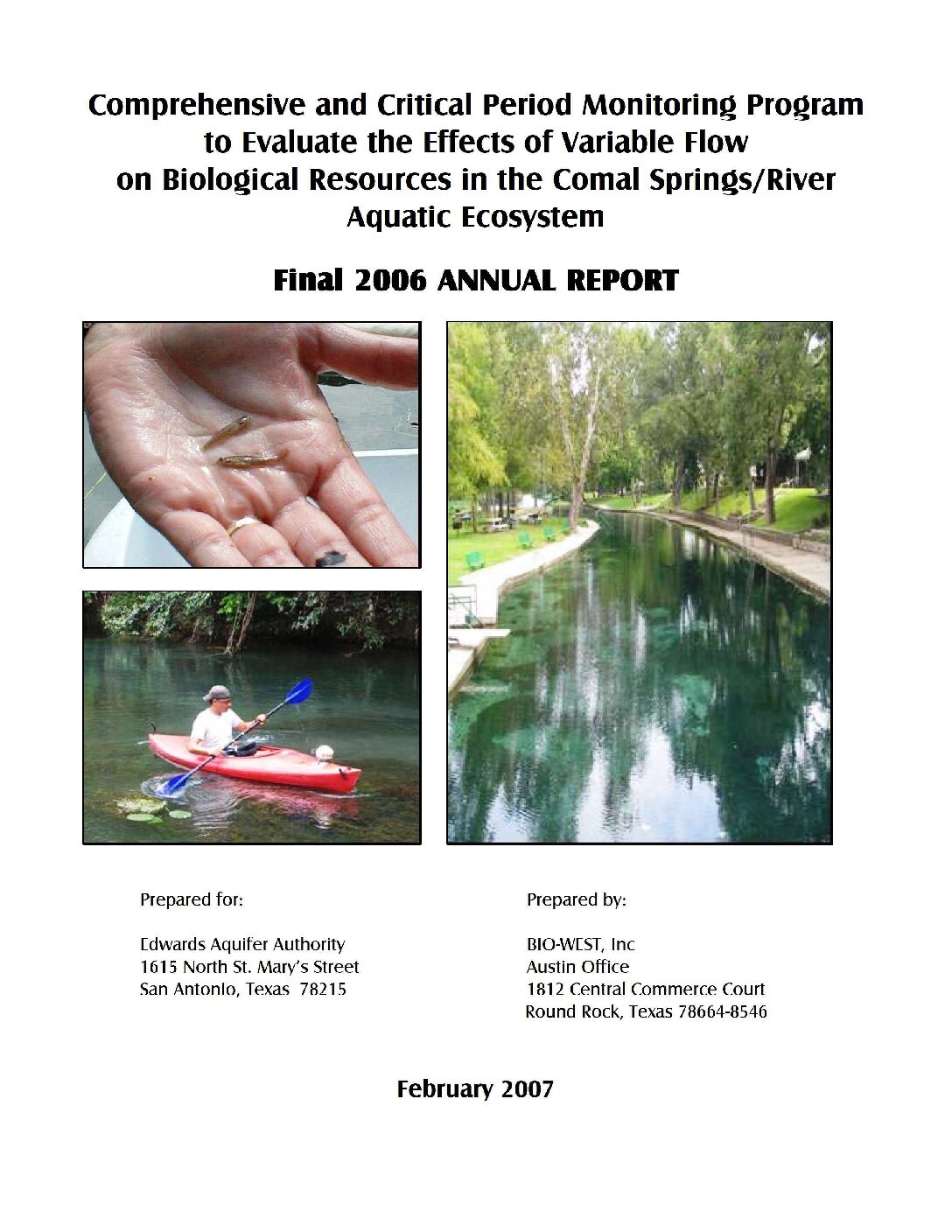
Description: Annual report for 2006 on biota study of Comal Springs/River
Location: Comal Springs/River
Summary:The purpose of this report is to document the results of all aquatic ecosystem monitoring conducted in 2006 at Comal Springs located in New Braunfels, Texas. The monitoring and report preparation was performed by BIO-WEST, Inc. Pflugerville, Texas.
[Excerpted from the Executive Summary]
Although discharge was considerably lower in 2006 than previous years, no Critical Period sampling events were triggered for this system. The lack of significant precipitation in 2006 caused the aquifer to drop to levels not observed in recent years.
Aquatic vegetation in the four sample reaches was mapped twice in 2006 to better understand discharge to vegetation growth relationships, and the relationship between fountain darter (Etheostoma fonticola) populations and their habitat. Overall, growth in vegetation was variable among the sites during 2006.
Size-class distributions of fountain darters in reaches furthest removed from spring influence demonstrated that larger fountain darters were more abundant in fall, and smaller darters were more numerous in spring indicating a spring reproductive peak. In the reaches closer to spring influence, a second peak of small darters was also seen in fall indicating that year-round reproduction does occur in certain areas. Last year, an effort was made to establish a rapid method for assessing changes in fountain darter population abundance between sample efforts, especially during Critical Periods (high- and low-flow events). This dip-netting protocol was continued in 2006 at all four sites. In 2006, darters were found in 70% of dips across all vegetation types in the spring, and 60% in the fall.
[N]o live specimens [of giant ramshorn snails] were collected during 2006 sampling efforts. However, since these snails can have severe impacts at high densities, their populations will continue to be monitored and remain a key focus during critical low-flow periods.
All SCUBA/snorkel surveys revealed the presence of Comal Springs salamanders along the lake bottom and in each sampled Spring Run in 2006. Though lower than average discharge was present in 2006, salamander populations remained consistent in the spring runs.
A total of 144 hours of sample time occurred among the three drift net sites at Comal Springs in 2006 and 11 species were captured. Population changes of species in 2006 were similar to previous years. Species of the genus Stygobromus and Lirceolus continued to be most abundant at all sites. Stygobromus pecki (Peck's cave amphipod) was the dominant amphipod
Initial observations of the gill parasite Heterophyid cercariae show that the Elizabeth Street site (Old Channel) has the highest abundance in the water column compared to the other two sites. In addition, concentrations of the parasite appeared to increase as discharge decreased. Since the intensive parasite evaluation began in 2006, there have been a total of thirteen rounds of parasite sampling, and an additional fifteen rounds will be completed before the study is completed in June 2007.
Overall, the most concerning observation in the Comal Springs / River ecosystem is that the Old Channel Reach is not nearly as productive as it had been during the early years of this study.
Ecology of the Exotic Giant Rams-Horn Snail, Marisa cornuarietis, Other Biological Characteristics and a Species/Ecological Review of the Literature of the Comal Springs Ecosystem of South Central Texas

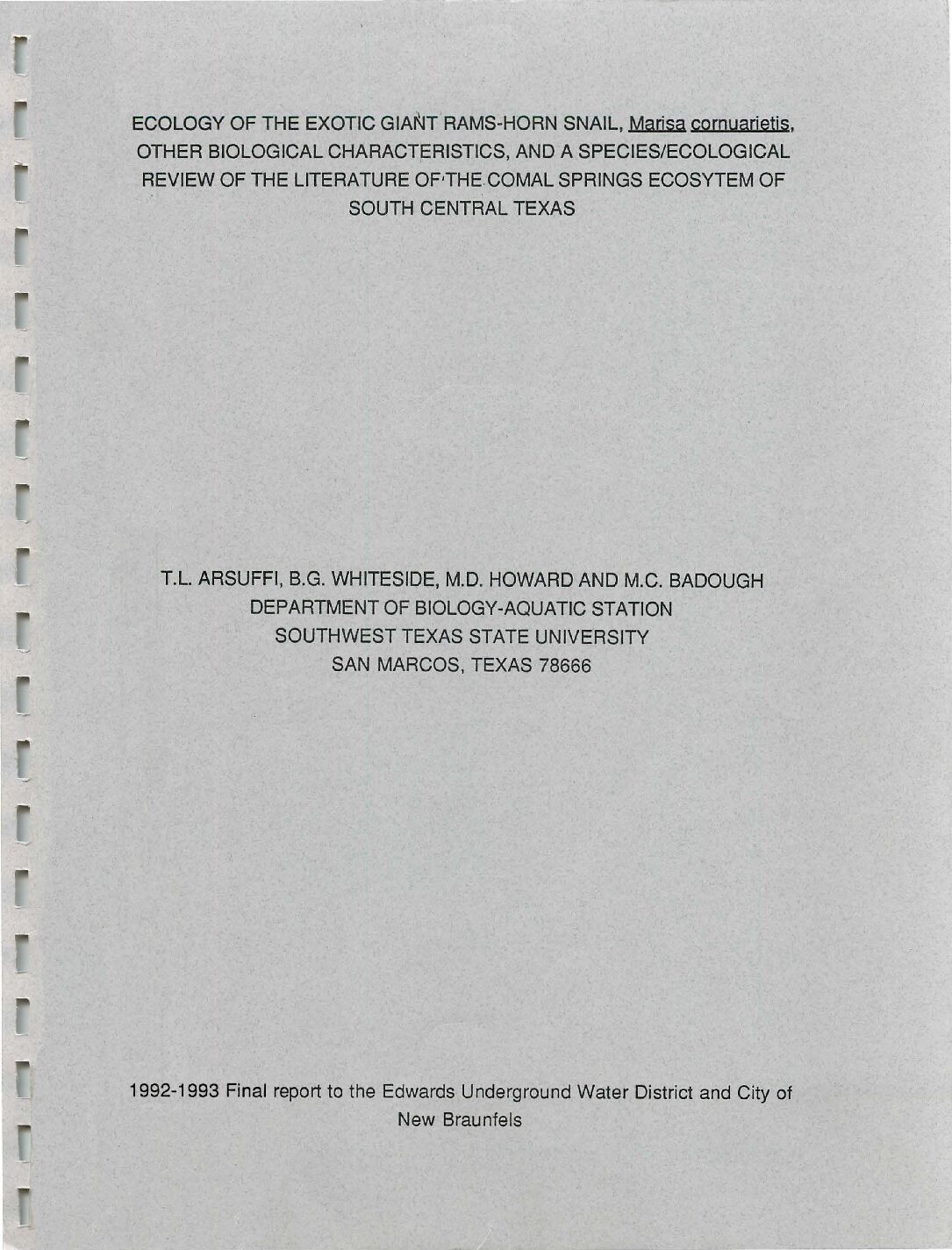
Description: Literature research on endangered species of the Edwards Aquifer, and field and laboratory studies on the giant rams-horn snail (Marisa cornuarietis)
Location: Comal Springs
Summary:Phase 1 is an ecological literature review and annotated bibliography of Fountain Darter (Etheostoma fontlcola), San Marcos Salamander (Eurycea nana), Comal Springs riffle beetle (Heterelmls comalensis), Peck's cave amphlpod (Stygobromus pecki), Comal Springs dryopld beetle (Stygoparnus comalensis), Giant rams-horn snail (Marisa cornuarietis).
Phase II is descriptive and manipulative field studies to determine the impact of the giant rams-horn snail (Marisa cornuarietis) on the Comal Springs aquatic ecosystem, and also laboratory feeding experiments.
Comprehensive and Critical Period Monitoring Program to Evaluate the Effects of Variable Flow on Biological Resources in the San Marcos Springs/River Aquatic Ecosystem Final 2004 Annual Report

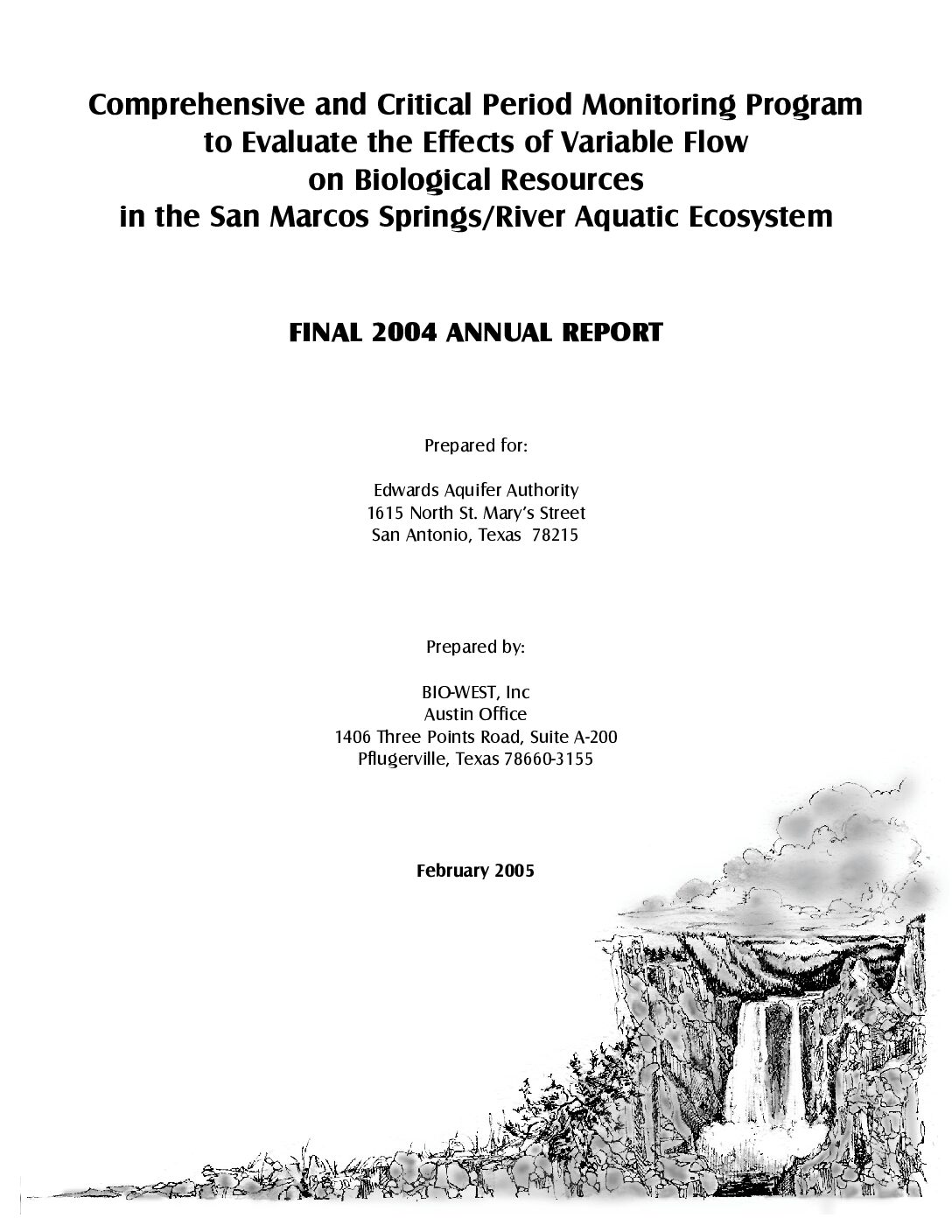
Description: Annual report for 2004 on biota study of San Marcos Springs/River
Location: San Marcos Springs/River
Summary:The purpose of this report is to document the results of all aquatic ecosystem monitoring conducted in 2004 at San Marcos Springs located in San Marcos, Texas. The monitoring and report preparation was performed by BIO-WEST, Inc. Pflugerville, Texas.
[Excerpted from the Executive Summary]
Because above-average flow conditions occurred during most of 2000-2004, there were no low-flow Critical Period events, but three high-flow Critical Period events in the San Marcos Springs/River ecosystem during that time. Overall water quality was assessed quarterly throughout the entire San Marcos River and in Spring Lake during 2000-2002 using standard parameters (water temperature, dissolved oxygen, pH, and conductivity) as well as conventional water chemistry parameters (nitrate, total nitrogen, ammonia, soluble reactive phosphorus, total phosphorus, alkalinity, and total suspended solids). This assessment suggested that all water quality parameters had relatively narrow ranges that were providing high quality conditions for aquatic life use.
Flooding resulted in a temporary reduction in total aquatic vegetation coverage in all reaches, but affected the IH-35 Reach most dramatically and the City Park Reach the least. However, many plant types quickly responded to the scouring flows with rapid re-growth and expanded to a total coverage that exceeded the pre-flooding condition. The plant type that was most susceptible to scour during flooding in the San Marcos Springs/River ecosystem was Cabomba, which occurs in areas of deep silt. It was also the highest quality habitat type (of those sampled quantitatively) for fountain darters in the San Marcos Springs/River ecosystem.
There was a substantial increase in total coverage of Texas wild-rice throughout the San Marcos River in 2000-2004. There are fewer abundant vegetation types in the San Marcos Springs/River ecosystem than in the Comal Springs/River ecosystem and the densities of fountain darters observed in the various vegetation types did not range as widely. The results show a relatively consistent estimate of the fountain darter population during 2000-2004 with some decrease associated with each high-flow event. These results revealed that discharge has had limited influence on fountain darter densities with the discharge that has occurred in 2000-2004. However, the limited data from low-flow conditions did not allow an extensive statistical assessment of fountain darter population dynamics. In general, the number of fountain darters per net in the San Marcos River was much lower than in the Comal River.
In addition to evaluating fountain darter population dynamics, the entire fish community was assessed by calculating species diversity in each sample reach during each sample effort in 2000-2004. There was no difference in diversity between the two reaches and no discernable patterns of change in diversity at the reach level during 2000-2004. One additional area of concern to fountain darters, the density of giant ramshorn snails (Marisa cornuarietis) was monitored in 2000-2004. By all indications the densities of giant ramshorn snails observed in the San Marcos Springs/River ecosystem during the study period to pose no serious threat to the aquatic vegetative community (i.e., fountain darter habitat). However, because of the impact that this exotic species can have under heavier densities, close monitoring of this species should continue. The gill parasite that has been reported to infect the fountain darter in the Comal Springs/River ecosystem was not visually evident in fountain darters collected from the San Marcos Springs/River ecosystem during 2000-2004.
Observations of the San Marcos salamander have varied in number within and between locations during 2000-2004, but individuals have been observed in each sample location during each sample period. Filamentous algae was abundant in most sampling events conducted during 2000-2004 in the sample site adjacent to the former Aquarena Springs Hotel and the deep site in Spring Lake and required clearing the algae prior to sampling efforts. This may have impacted sampling efficiency. Regardless, the Hotel site consistently had the highest number of San Marcos salamanders.
More data from low-flow periods (particularly from an extended low-flow period) are essential to fully evaluate the biological risks associated with future critical periods (high or low flow). This study remains the most comprehensive biological evaluation that has ever been conducted on the San Marcos Springs/River ecosystem.
Comprehensive and Critical Period Monitoring Program to Evaluate the Effects of Variable Flow on Biological Resources in the Comal Springs/River Aquatic Ecosystem Final 2004 Annual Report

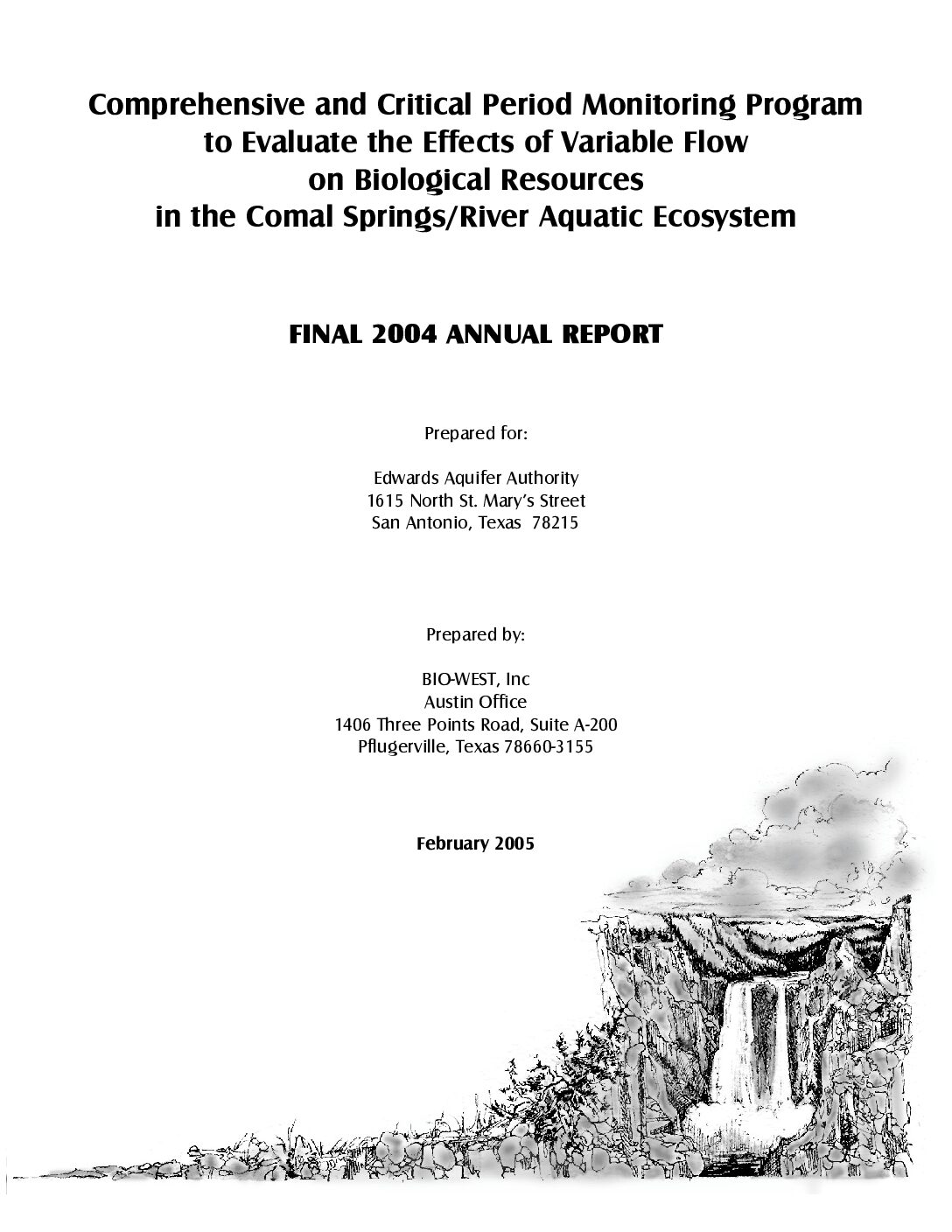
Description: Annual report for 2004 on biota study of Comal Springs/River
Location: Comal Springs/River
Summary:The purpose of this report is to document the results of all aquatic ecosystem monitoring conducted in 2004 at Comal Springs located in New Braunfels, Texas. The monitoring and report preparation was performed by BIO-WEST, Inc. Pflugerville, Texas.
[Excerpted from the Executive Summary]
Because above-average flow conditions occurred during most of 2000-2004, there were only two low-flow Critical Period events, but four high-flow Critical Period events in the Comal Springs/River ecosystem during that time.
Overall water quality was assessed quarterly throughout the entire Comal River during 2000-2002 using standard parameters (water temperature, dissolved oxygen, pH, and conductivity) as well as conventional water chemistry parameters (nitrate, total nitrogen, ammonia, soluble reactive phosphorus, total phosphorus, alkalinity, and total suspended solids). This assessment suggested that all water quality parameters had relatively narrow ranges that were providing high quality conditions for aquatic life use.
For the fountain darter, habitat use is largely influenced by aquatic vegetation and assessments of habitat availability were conducted by mapping this vegetation during each sampling event. Throughout the study, aquatic vegetation remained abundant in most reaches despite the frequent scouring associated with flooding. The most highly affected plant types tended to be the vegetation types that support the highest densities of fountain darter. These results indicate the strong influence of bryophytes on the total population of fountain darters in the Comal Springs/River ecosystem.
Drop net data also provided information on the overall size-class distribution for the Comal Springs/River ecosystem, which continues to indicate a healthy fish assemblage. In addition, species diversity was calculated for the entire fish community in each reach during each sample effort in 2000-2004. Though there were some differences in natural diversity among reaches, there were no discernable patterns of change in diversity at the reach level during 2000-2004.
By all indications the density of giant ramshorn snails observed in the Comal ecosystem during the study period to date (including the 2000 low-flow events) pose no serious threat to the aquatic vegetative community (i.e., fountain darter habitat). However, because of the impact that this exotic species can have under heavier densities, close monitoring of this species should continue.
Gill parasites varied substantially in abundance among sample sites during this study, but variation among seasons was less pronounced.[M]ore studies are needed to evaluate the relationships between snails and abundance of parasites.
Observations of Comal Springs salamander have varied in number within and between locations during 2000-2004, but individuals have been observed in each sample location during each sample period. There was no distinct pattern of variation in salamander abundance with changes in discharge; however, there was a trend of increasing numbers of salamanders surveyed in the eastern outfall adjacent Spring Island in 2003 and 2004.
[T]here was a distinct influence of high-flows on the 2004 samples. However, despite the differences in springflow conditions relative to 2003, many of the findings in 2004 were very similar to those in 2003.
The new sample method for Comal Springs riffle beetles, adopted in 2004, provided a larger sample size which improved the ability to evaluate potential differences in population abundance among sites, seasons and with different depths and flows. Previous sampling indicated that there were differences in population size among the three sample areas, but there were similar numbers of Comal Springs riffle beetles (adults and larvae) observed in all sites in 2004. There were also data to suggest that the species has precise requirements (e.g., physical characteristics or food source) that govern its distribution.
This study remains the most comprehensive biological evaluation that has ever been conducted on the Comal River ecosystem.
Comprehensive and Critical Period Monitoring Program to Evaluate the Effects of Variable Flow on Biological Resources in the San Marcos Springs/River Aquatic Ecosystem Final 2001 Annual Report Appendix C: Drop Net Raw Data

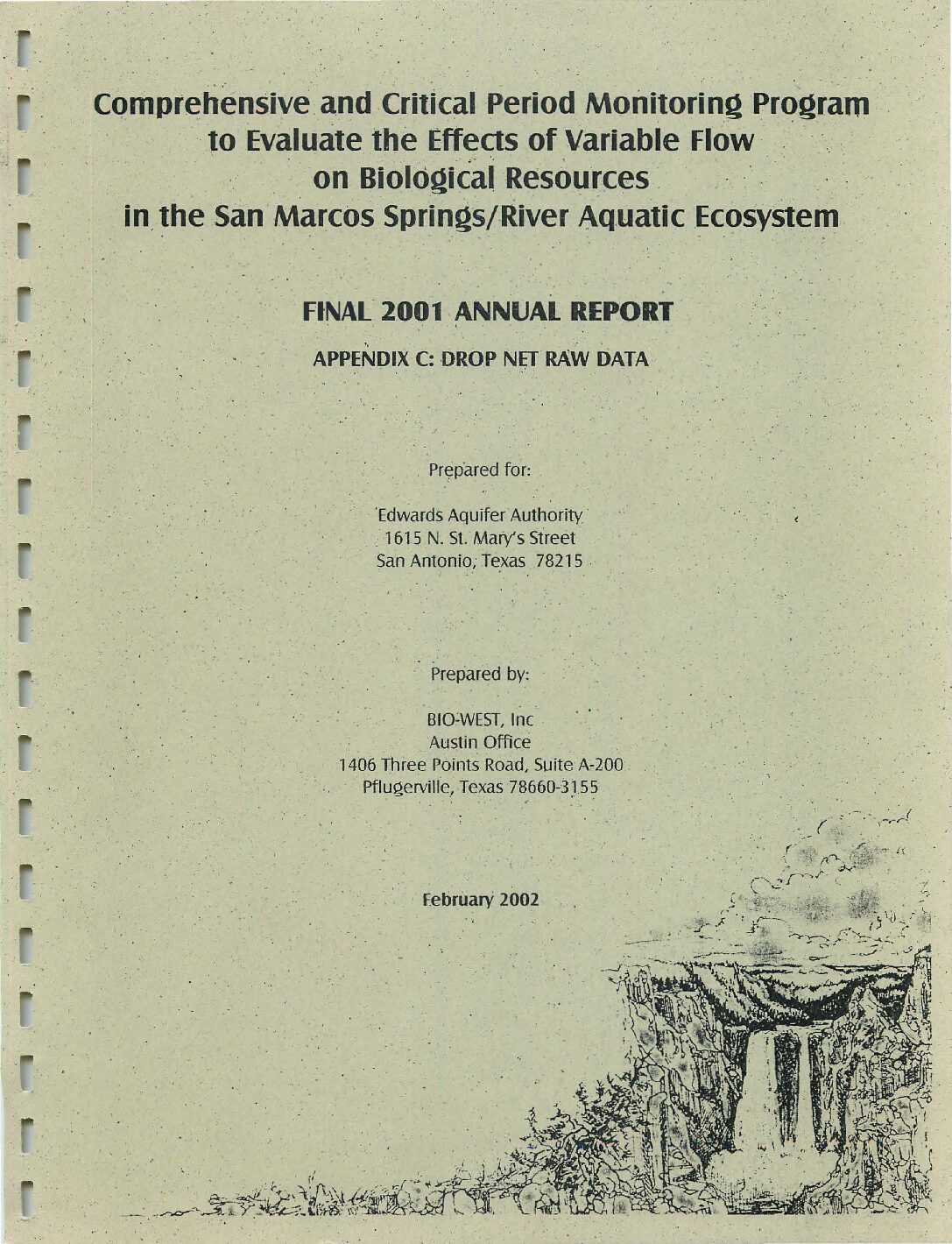
Description: Raw drop-net data for the 2001 Annual report on biota study of San Marcos Springs/River
Location: San Marcos Springs/River
Summary:This Appendix is a compilation of quarterly raw drop-net data for the 2001 San Marcos Springs/River critical periods study in San Marcos, Texas. Data collection points were at City Park and I-35. The monitoring and report preparation was performed by BIO-WEST, Inc. Pflugerville, Texas.
Comprehensive and Critical Period Monitoring Program to Evaluate the Effects of Variable Flow on Biological Resources in the Comal Springs/River Aquatic Ecosystem Final 2005 Annual Report

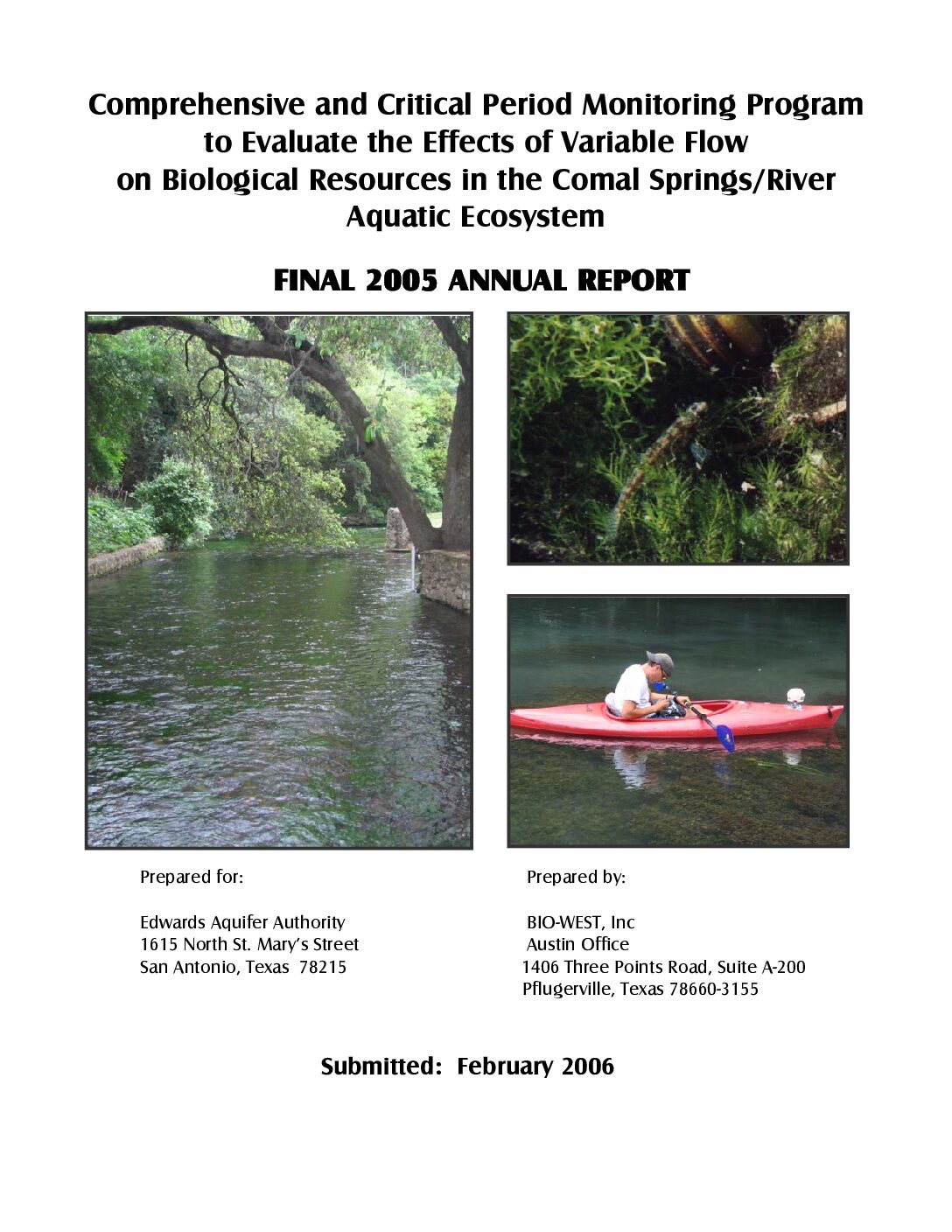
Description: Annual report for 2005 on biota study of Comal Springs/River
Location: Comal Springs/River
Summary:The purpose of this report is to document the results of all aquatic ecosystem monitoring conducted in 2005 at Comal Springs located in New Braunfels, Texas. The monitoring and report preparation was performed by BIO-WEST, Inc. Pflugerville, Texas.
[Excerpted from the Executive Summary]
There were no low-flow critical periods or high-flow events triggered in 2005. Flows were consistently higher than that of the average historical record for the entire year in the Comal River. [W]e have not been able to acquire the necessary range of data from all flow levels (specifically low-flow) to conduct stringent data reduction techniques or statistical applications.
Overall, vegetation coverage increased at all sites following the high-flows of 2004. In most cases, flooding resulted in a temporary reduction in total aquatic vegetation coverage, but many plant types quickly responded with rapid re-growth and expanded to a total coverage that exceeded the preflooding condition.
Overall, the size-class distribution for fountain darters collected during the study period is typical of a healthy fish population with a peak near 30 millimeters (mm) total length (TL). In 2005, an effort was made to establish a rapid method for assessing changes in fountain darter population abundance between sample efforts, especially during critical periods (high- and low-flow events).
Although not a fish, one exotic species which has had considerable impact on the vegetation community in the Comal Springs/River ecosystem in the past is the giant ramshorn snail (Marisa cornuarietis). Densities of these organisms have declined in recent years, and were at their lowest in 2005. However, since these snails can have severe impacts at high densities, their populations will continue to be monitored especially if a critical low-flow period occurs in 2006. In 2005, new methods were tested to help better identify changes in gill parasite drift densities during the year. These new methods will be implemented in 2006 to better understand drift rates of the parasite and infection rates of fountain darters.
All SCUBA/snorkel surveys revealed the presence of Comal Springs salamanders (Eurycea sp.) along the Landa Lake bottom and in each sampled Spring Run, except for the Spring Run at Spring Island in fall 2005.
Among species of concern, an average of 14.5 Stygobromus pecki (Peck's cave amphipod, many small Stygobromus were unidentifiable to species), 3.2 Heterelmis comalensis (Comal Springs riffle beetle), and 1.3 Stygoparnus comalensis (Comal Springs dryopid beetle) were retrieved during each 24-hour period at all sites. S. pecki was found in all three locations.
A total of 1,009 Comal Springs riffle beetles were collected in all 2005 samples and the number of larvae (n=227) was far fewer than the number of adults (n=782). The sampling methodology used in 2004-2005 has revealed a much larger population of Comal Springs riffle beetle along the western shoreline of Landa Lake than previous sampling had suggested.These data suggest that the species has precise requirements (e.g., physical characteristics or food source) that govern its distribution.
Though the comprehensive portion of the study has been reduced to two annual samples (plus a limited summer effort), it is still adequate to maintain a continuous record of conditions. That is vital knowledge since antecedent conditions influence community-level response to reduced discharge conditions. Sampling only during a low-flow event will not provide the necessary context to adequately assess changes that occur during such conditions.
Comprehensive and Critical Period Monitoring Program to Evaluate the Effects of Variable Flow on Biological Resources in the Comal Springs/River Aquatic Ecosystem Final 2002 Annual Report

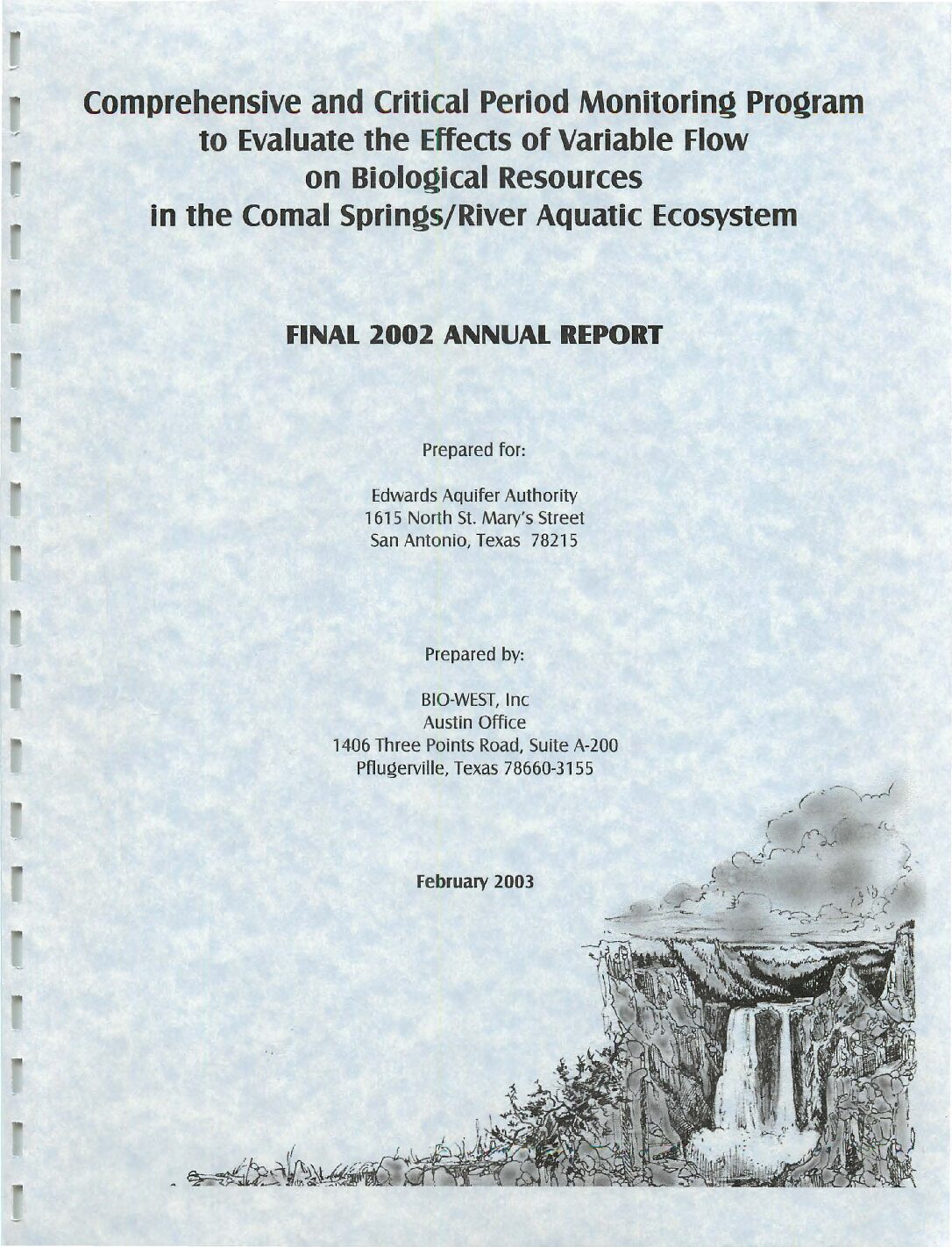
Description: Annual report for 2002 on biota study of Comal Springs/River
Location: Comal Springs/River
Summary:The purpose of this report is to document the results of all aquatic ecosystem monitoring conducted in 2002 at Comal Springs located in New Braunfels, Texas. The monitoring and report preparation was performed by BIO-WEST, Inc. Pflugerville, Texas.
[Excerpted from the Executive Summary]
As in 2001, there were no low-flow critical periods triggered in 2002; however, a high-flow event occurred during the summer (24-hour mean discharge reached levels that have occurred less than 0.1% of the time in the recorded hydrograph). This sample event replaced the summer quarterly sample and a previously unscheduled fall quarterly sample was conducted as a result.
Aquatic vegetation has remained abundant throughout the study period (2000-present) and has provided suitable habitat for biological communities. In the Old Channel Reach, filamentous algae was nearly completely scoured in 2002 as it was by the flood in fall 2001. This is significant because of the importance of this vegetation type to fountain darters (Etheostoma fonticola).[A]fter the summer 2002 flood, fountain darter densities were low relative to the previous sampling event.As in the San Marcos River ecosystem, flooding has had significant short-term impacts on fountain darter habitat and the vegetation types with the greatest suitability were the most susceptible (filamentous algae and bryophytes). Two additional parameters were noted during fountain darter sampling, the density of giant ramshorn snails (Marisa cornuarietis) and evidence of gill parasites on fountain darters.
Drift net sampling for benthic macroinvertebrates was completed with the spring quarterly sample. In the spring runs and at the springs' orifices, suitable habitat for the federally endangered invertebrates was observed throughout the study period. Suitable habitat for the Comal Springs salamander (Eurycea sp.) was noted in the spring runs and Spring Island area; Comal Springs salamanders were observed in each area during each sampling event.
More data from lowflow periods (particularly from an extended low-flow period) are essential to fully evaluate the biological risks associated with future critical periods (high or low flow).This study remains the most comprehensive biological evaluation that has ever been conducted on the Comal River ecosystem.
Comprehensive and Critical Period Monitoring Program to Evaluate the Effects of Variable Flow on Biological Resources in the Comal Springs/River Aquatic Ecosystem Final 2001 Annual Report

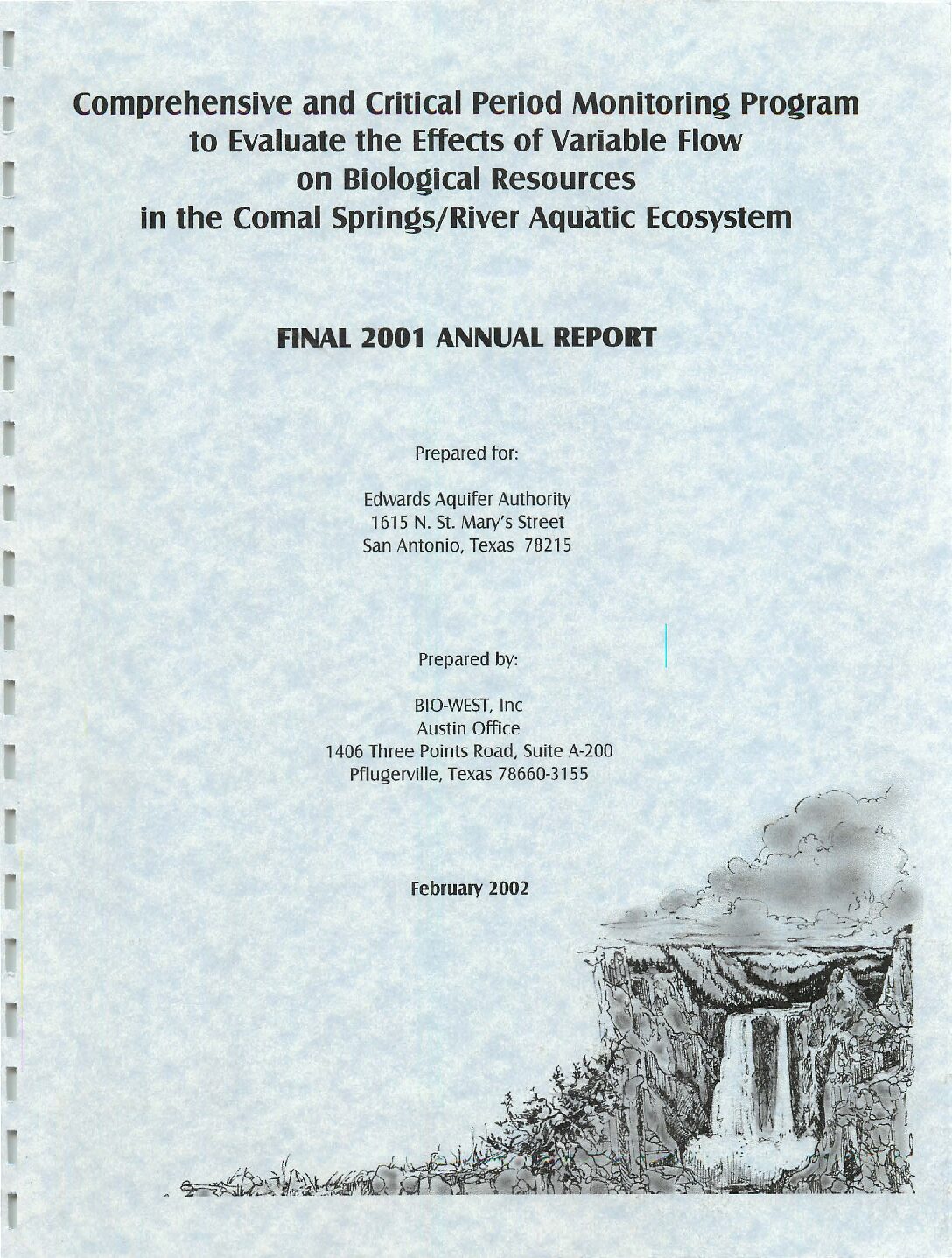
Description: Annual report for 2001 on biota study of Comal Springs/River
Location: Comal Springs/River
Summary:The purpose of this report is to document the results of all aquatic ecosystem monitoring conducted in 2001 at Comal Springs located in New Braunfels, Texas. The monitoring and report preparation was performed by BIO-WEST, Inc. Pflugerville, Texas.
[Excerpted from the Executive Summary]
During 2001 the conditions in the Comal ecosystem were representative of a normal-to-wet winter and spring followed by the typical summertime decline. However, unlike summer 2000, a significant rainfall event occurred in late summer (September 2001) and moderate-to-high rainfall conditions occurred throughout the remainder of the fall, including another major event in November 2001. As a result, no critical period samples were triggered by low-flow events in 2001; yet two sampling events were conducted following the periods of intense flooding in which the 24-hour mean discharge in the Comal River reached levels that have occurred less than 0.5% of the time in the recorded hydrograph. In each case sampling was conducted after the ecosystem had returned to normative conditions in order to evaluate the postflooding effects, but not so soon that sampling would be influenced by immediate, ephemeral impacts occurring during the elevated flow conditions.
Throughout this time period the Comal ecosystem can be characterized as an ecosystem with very high water quality for the chemical and physical variables that were measured. Aquatic vegetation remained abundant throughout the study period and provided suitable habitat for biological communities. Fountain darters were collected from each reach sampled reach during each sampling event. The overall size class distribution for the Comal ecosystem represents that of a healthy fish assemblage
By all indications the densities of giant ramshorn snails (Marisa cornuarietis) observed in the Comal ecosystem during the study period to date (including the 2000 low-flow events) pose no serious threat to the aquatic vegetative community. However, because of the impact that this exotic species can have under heavier densities, close monitoring of this species should continue. The gill parasite that has been reported for the fountain darter was evident in a number of collected fountain darters.
Within the spring runs and at the springs' orifices, suitable habitat for the listed invertebrates was observed throughout the study period. Several Comal Springs riffle beetle (Heterelmis comalensis) adults and larvae were collected in the drift nets throughout the year. A major discovery in 2001concerning invertebrates was the extension of the known range for the Comal Springs riffle beetle.
Suitable habitat for the Comal Springs salamander (Eurycea sp.) was noted in the spring runs and Spring Island area with Comal Springs salamanders observed in each area for each sampling event.
One conclusion that can be made is that this study is the most comprehensive biological evaluation that has ever been conducted on the Comal ecosystem.
Comprehensive and Critical Period Monitoring Program to Evaluate the Effects of Variable Flow on Biological Resources in the San Marcos Springs/River Aquatic Ecosystem Final 2011 Annual Report

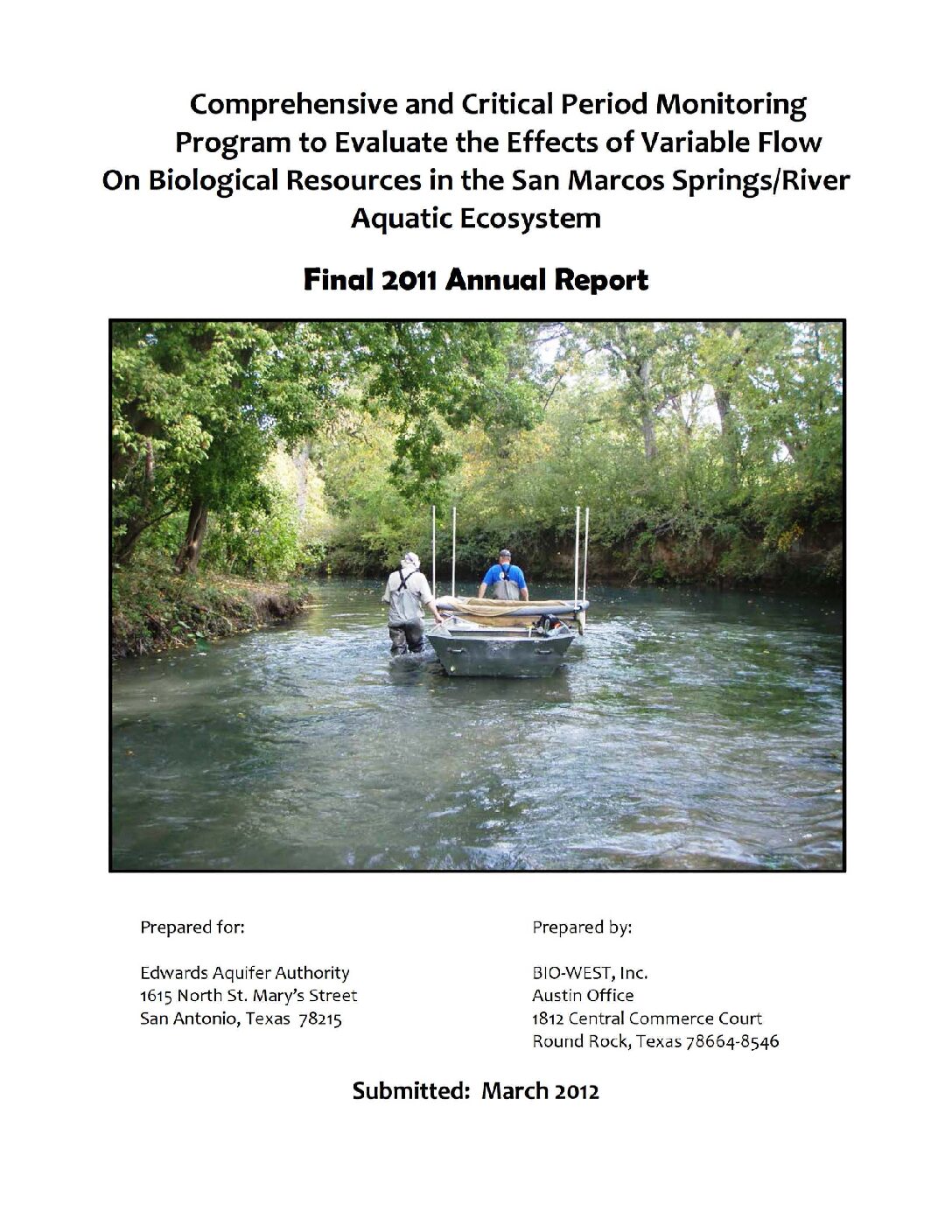
Description: Annual report for 2011 on biota study of San Marcos Springs/River
Location: San Marcos Springs/River
Summary:The purpose of this report is to document the results of all aquatic ecosystem monitoring conducted in 2011 at San Marcos Springs located in San Marcos, Texas. The monitoring and report preparation was performed by BIO-WEST, Inc. Pflugerville, Texas.
[Excerpted from the Executive Summary]
Flows in the San Marcos River in 2011 were similar to previous low flow years (2006, 2009), and similar effects were observed. A decrease in Texas wild-rice coverage and fountain darter population estimates reflected the impact of increased recreation pressure under low flow conditions. However, San Marcos salamander densities remained high despite the lower than average flow conditions. Since salamander habitat is limited to areas near spring upwellings at the head of the system (much of which is under Spring Lake and thus protected from recreation), habitat quality for these animals is influenced less by low-flow conditions and increased recreation pressure. Ongoing changes in spring discharge, recreation pressure, exotic species, and other factors make continued monitoring of this system critical to inform management decisions.
Comprehensive and Critical Period Monitoring Program to Evaluate the Effects of Variable Flow on Biological Resources in the Comal Springs/River Aquatic Ecosystem Final 2011 Annual Report

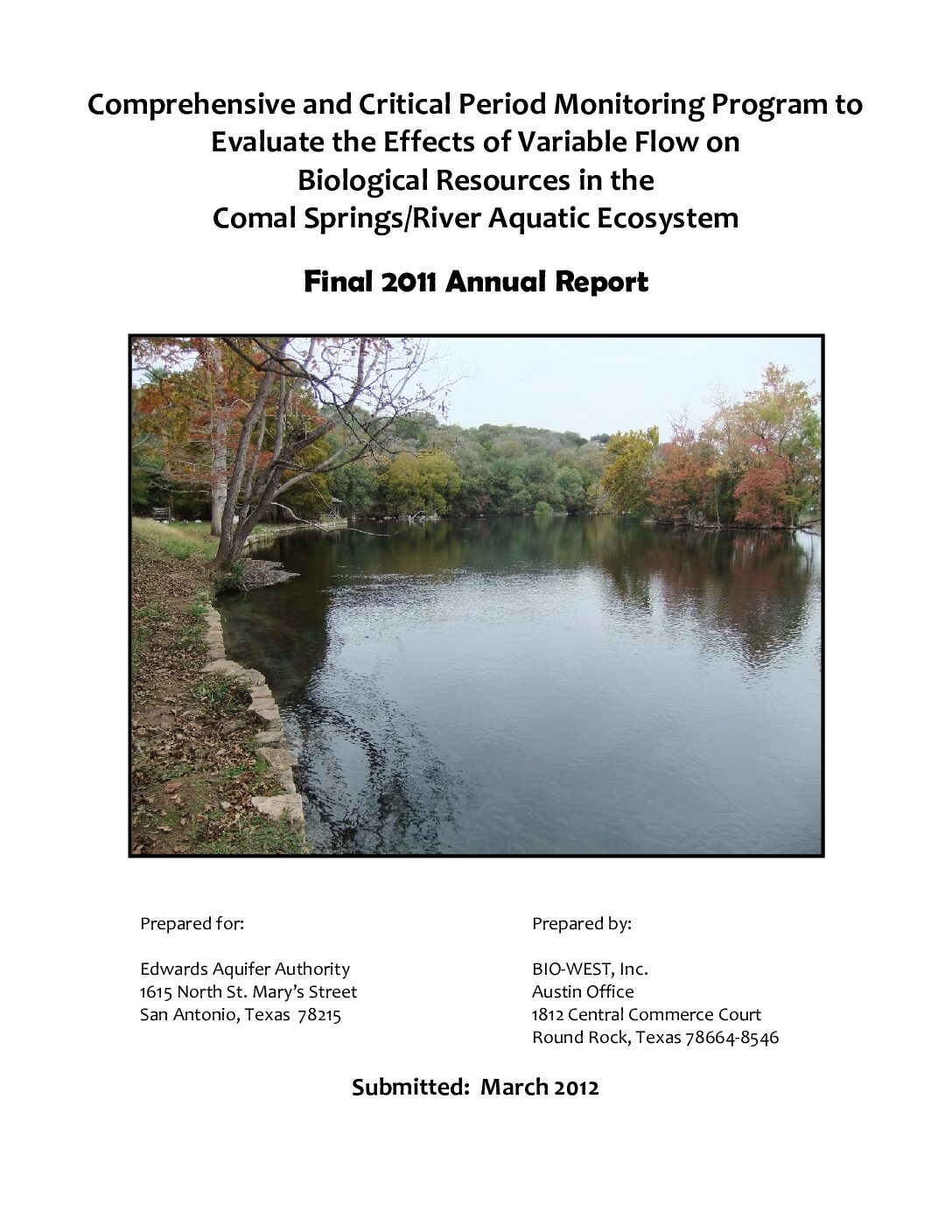
Description: Annual report for 2011 on biota study of Comal Springs/River
Location: Comal Springs/River
Summary:The purpose of this report is to document the results of all aquatic ecosystem monitoring conducted in 2011 at Comal Springs located in New Braunfels, Texas. The monitoring and report preparation was performed by BIO-WEST, Inc. Pflugerville, Texas.
[Excerpted from Executive Summary]
Following the major flood event in June 2010, the Comal River (and much of Central Texas) plunged into one of the worst droughts in history. As summer air temperatures increased and precipitation was sparse, flows continued to drop in the Comal River. These back to back events provided a unique opportunity to assess the aquatic community, evaluate stressors and compare observations to previous lower than average years. The 2011 Variable Flow study data indicated continued deleterious effects in the Upper Spring Run Reach on both aquatic vegetation and fountain darter populations as full recovery from the 2010 major flood event had not been accomplished in this reach prior to the extended period of drought.
Less severe, but negative effects on aquatic vegetation and fountain darter populations were evident in Landa Lake during the majority of 2011. Aquatic vegetation and fountain darter conditions within the Old Channel remained consistent with post-culvert reconstruction conditions, while New Channel conditions improved during 2011.
Neither water quality parameters measured (including water temperature) throughout the Comal Springs/River ecosystem, nor endangered macroinvertebrate habitat or population data posed concern during the extended drought witnessed in 2011. As such, the juxtaposition of high and low-flow events in 2010 and 2011 caused impacts (some severe) in the certain reaches of the ecosystem, but overall the aquatic communities presently remain intact. As the drought continues, or is broken it will be invaluable to continue to monitor the response and/or recovery of the Comal Springs/River ecosystem.
 Conditions
Conditions

 CURRENT
CURRENT 
